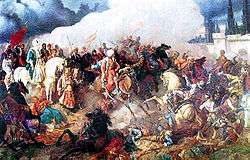Battle of Otlukbeli
| ||||||||||||||||||||||||||||||
The Battle of Otlukbeli or Otluk Beli was a battle between Ak Koyunlu and the Ottoman Empire that was fought on August 11, 1473.
Reasons for the conflict
Mehmed II's aggressive military policy in capturing the throne of the Byzantine Empire resulted in the Fall of Constantinople in 1453. Independent Byzantine Greek rulers continued to rule in some areas after this event. One of these domains was the Empire of Trebizond. When Mehmed was to turn his face to the East to clean up the remnants of Byzantine rule in 1461, he was faced with another Central Asian originated power, the Ak Koyunlu, a tribe that ruled huge lands in the Eastern Anatolia.
Their leader, Uzun Hasan, continued the tradition of close relations between the Byzantine throne and his own kingdom so he supported the Empire of Trebizond and sent them military aid but his support wasn't enough to save Trebizond from the Ottoman forces. Mehmed II conquered all of the Eastern Black Sea region. Uzun Hasan decided to seek help from Christian powers because he thought that the Ottomans would return for his own kingdom. Therefore, he decided to sign a treaty with the Republic of Venice, the rival of the Ottoman Empire at that time.
In response to Uzun Hasan's treaty with Venice, The Ottoman Sultan Mehmet II first sent various Janissary contingents, commanded by various figures including Radu cel Frumos, these contingents guarded crucial garrisons and awaited the Ottoman onslaught on the Anatolian rebels.
Another reason for tensions between Ak Koyunlu and Ottomans was the political standing of another powerful Anatolian tribe, Karamanids. Kasım Bey, the ruler of Karamanids, was supporting the growing power of Uzun Hasan. These two powers were working in cooperation against the Ottoman advance in Anatolia. In 1471, a successful Ottoman operation against Karamanids reduced the power of the tribe. This gave courage to Mehmed II to move deeper into Anatolia.
Battle
Mehmed II returned with his army in 1473 to defeat Uzun Hasan. The Turcomans had a traditional army that contained considerable amounts of light cavalries. On the other hand, the Ottoman army was using the latest technology. They came with handguns and cannons. This difference between the natures of the two armies marked the result of the battle. The Ottoman side gained a decisive victory, where as the Turcoman army was nearly destroyed in a single day.
Aftermath
Ottomans nearly destroyed the power of the Ak Koyunlu in the East. Ak Koyunlu would be destroyed completely by Shah Ismail of Iran in later years. This victory of the Safavid Empire would create a new enemy for Ottoman Empire in the East. The race between two empires ended with the fall of the Safavid dynasty from power in the 18th century.
See also
References
- ↑ Somel, Selçuk Akşin, Historical dictionary of the Ottoman Empire, (Scarecrow Press Inc., 2003), xc.
- ↑ Babinger, Franz (1992). Mehmed the Conqueror and His Time. Princeton University Press. p. 315. ISBN 978-0-691-01078-6. Retrieved 10 April 2011.
- ↑ Har-El, Shai (1995). Struggle for domination in the Middle East: the Ottoman-Mamluk War, 1485-91. BRILL. p. 149. ISBN 978-90-04-10180-7. Retrieved 6 October 2010.
